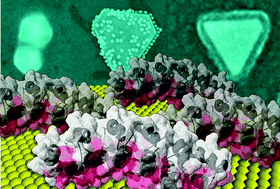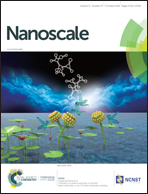Directed evolution of artificial repeat proteins as habit modifiers for the morphosynthesis of (111)-terminated gold nanocrystals†
Abstract
Natural biocomposites are shaped by proteins that have evolved to interact with inorganic materials. Protein directed evolution methods which mimic Darwinian evolution have proven highly successful to generate improved enzymes or therapeutic antibodies but have rarely been used to evolve protein–material interactions. Indeed, most reported studies have focused on short peptides and a wide range of oligopeptides with chemical binding affinity for inorganic materials have been uncovered by phage display methods. However, their small size and flexible unfolded structure prevent them from dictating the shape and crystallinity of the growing material. In the present work, a specific set of artificial repeat proteins (αRep), which exhibit highly stable 3D folding with a well-defined hypervariable interacting surface, is selected by directed evolution of a very efficient home-built protein library for their high and selective affinity for the Au(111) surface. The proteins are built from the extendable concatenation of self-compatible repeated motifs idealized from natural HEAT proteins. The high-yield synthesis of Au(111)-faceted nanostructures mediated by these αRep proteins demonstrates their chemical affinity and structural selectivity that endow them with high crystal habit modification performances. Importantly, we further exploit the protein shell spontaneously assembled on the nanocrystal facets to drive protein-mediated colloidal self-assembly and on-surface enzymatic catalysis. Our method constitutes a generic tool for producing nanocrystals with determined faceting, superior biocompatibility and versatile bio-functionalization towards plasmon-based devices and (bio)molecular sensors.



 Please wait while we load your content...
Please wait while we load your content...